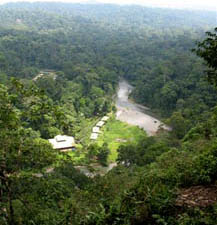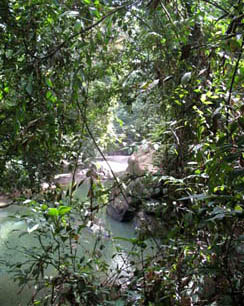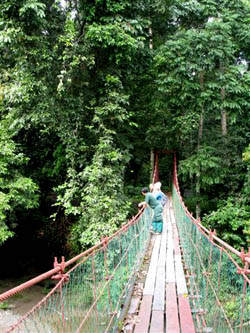The Jungles of Borneo
Danum Valley, Sabah, Borneo
by Sarah Shuckburgh
The noises emanating from
Borneo's rainforest are thrilling, but to discover what's
making them, you'll need a guide, says Sarah Shuckburgh.
 In
the early morning, the view from my verandah is magical.
Mist hangs in the trees, forming a white veil from which
only the tallest treetops emerge. Three sambar deer step
daintily past a clump of teak trees near my chalet, leaning
up to nibble the huge heart-shaped leaves. Nearby, a large
bearded pig snuffles in the undergrowth. The sounds, too,
are thrilling. Barking lizards grunt, a brown barbet makes a
repetitive ‘tonk-tonk’ call, and cicadas, unlike our quiet
European kinds, sound like dentists’ drills. From the
jungle, gibbons whoop their ululating greetings. As the mist
lifts, I spot a family of orang utans, swinging through the
distant canopy. Further down, branches shake as other
primates leap through the trees. In
the early morning, the view from my verandah is magical.
Mist hangs in the trees, forming a white veil from which
only the tallest treetops emerge. Three sambar deer step
daintily past a clump of teak trees near my chalet, leaning
up to nibble the huge heart-shaped leaves. Nearby, a large
bearded pig snuffles in the undergrowth. The sounds, too,
are thrilling. Barking lizards grunt, a brown barbet makes a
repetitive ‘tonk-tonk’ call, and cicadas, unlike our quiet
European kinds, sound like dentists’ drills. From the
jungle, gibbons whoop their ululating greetings. As the mist
lifts, I spot a family of orang utans, swinging through the
distant canopy. Further down, branches shake as other
primates leap through the trees.
 I am staying at the Borneo Rainforest Lodge in the middle of
the largest surviving area of primary forest in Sabah.
Today, palm-oil plantations cover most of north Borneo, and
lorries laden with hardwood trundle in convoys from other
remnants of jungle. But the Sabah government has decreed a
30-year ban on logging from 2008, and in the Danum Valley,
175 square miles of lowland rainforest have been designated
a protected reserve. The field centre here is one of the
leading tropical rainforest research stations in South East
Asia, and the nearby lodge is an eco-friendly guesthouse
with 23 stilted huts built of local wood and stones from the
Danum riverbed. I am staying at the Borneo Rainforest Lodge in the middle of
the largest surviving area of primary forest in Sabah.
Today, palm-oil plantations cover most of north Borneo, and
lorries laden with hardwood trundle in convoys from other
remnants of jungle. But the Sabah government has decreed a
30-year ban on logging from 2008, and in the Danum Valley,
175 square miles of lowland rainforest have been designated
a protected reserve. The field centre here is one of the
leading tropical rainforest research stations in South East
Asia, and the nearby lodge is an eco-friendly guesthouse
with 23 stilted huts built of local wood and stones from the
Danum riverbed.
 Equipped with leech socks (one-size-fits-all canvas bags
worn inside trainers) I set off on sodden jungle trails with
Donny, the chief naturalist guide. Towering trees, 400 years
old, are surrounded by slender buttresses which create
cave-like antechambers. Huge fallen trunks are covered in
fungi and glistening spiders’ webs. The ground is a dense
mass of fallen leaves and branches. It’s hot, and with
humidity often at 100%, nothing evaporates. Flies, desperate
for salt, land on my sweating body. Equipped with leech socks (one-size-fits-all canvas bags
worn inside trainers) I set off on sodden jungle trails with
Donny, the chief naturalist guide. Towering trees, 400 years
old, are surrounded by slender buttresses which create
cave-like antechambers. Huge fallen trunks are covered in
fungi and glistening spiders’ webs. The ground is a dense
mass of fallen leaves and branches. It’s hot, and with
humidity often at 100%, nothing evaporates. Flies, desperate
for salt, land on my sweating body.
A giant millipede curls up into a ball in alarm as we
approach, but I find it hard to spot forest wildlife. Donny
sees clues everywhere. He points to an orang-utan nest of
folded branches in a treetop. A pile of fruit seeds and
scats under another tree show where the orang-utan had
breakfast. These holes in the ground were made by foraging
wild boar; this flattened circle of earth, cleared of
leaves, is the mating area of a silvery-grey argus pheasant;
and that tangle of bent llianas was trampled by an elephant.
 Donny explains the medicinal uses of each tree - one
secretes resin that is used in HIV medicines, another
produces poisonous sap which kills fish if it is sprinkled
on the river, and the sap from a third tree prevents malaria
– Donny drinks an infusion of this every month. Donny explains the medicinal uses of each tree - one
secretes resin that is used in HIV medicines, another
produces poisonous sap which kills fish if it is sprinkled
on the river, and the sap from a third tree prevents malaria
– Donny drinks an infusion of this every month.
At the riverbank, we watch a cavorting family of long-tailed
macaques on the far bank. They swing on llianas and push
each other into the brown sunlit river from the spindly
branches of a fruit-tree. At my feet, an agamid lizard, like
a twelve-inch dinosaur, stalks nonchalantly by.
All day, leeches, blind but cunning, sense our approach, and
groping from leaf tips, clamp themselves to our legs, arms,
necks and backs as we pass. Only our shins and ankles are
safe, inside the canvas socks. Donny has the answer – he
strokes the leech to confuse it and as it loosens its grip,
sharply flicks it away. My leeches aren’t easily confused,
so Donny obligingly flicks them for me.
 We
follow a narrow path to a waterfall which thunders into a
circular pool of muddy grey-green, forming a natural jacuzzi.
The canopy almost blocks out the sky, but a small blue gap
admits a shaft of sunshine. A kingfisher skims over the
patch of sunlit water. This is a perfect place to cool off. We
follow a narrow path to a waterfall which thunders into a
circular pool of muddy grey-green, forming a natural jacuzzi.
The canopy almost blocks out the sky, but a small blue gap
admits a shaft of sunshine. A kingfisher skims over the
patch of sunlit water. This is a perfect place to cool off.
Donny tells me that he comes from the Orang Sungai tribe –
the ‘river people’ - whose traditional lands included the
area where the lodge now stands. Danum was the name of a
brave tribal king, a warrior who set off into the forest and
was gone for so long that one of Donny’s ancestors was
elected king to replace him. When Danum came back,
unexpectedly safe and sound, he deferred to the new king. In
honour of his bravery and his modesty, Donny’s ancestor
named the river and surrounding area after him.
After the Second World War, when the British took over from
the Borneo Company, tribal people were encouraged to give up
their nomadic life of hunting, gathering, and growing rice
on temporary fields. Donny’s family started work on tobacco
plantations, and converted to Anglicanism. Donny’s Christian
name was chosen by the Australian missionary who baptised
him.
After our dip, we clamber up roughly-cut steps to a
rock-shelf overlooking the horseshoe curve of the river and
the lodge. Here, members of Donny’s tribe traditionally
brought their dead; from this vantage point the spirits
could watch over their descendants. Burying a body
underground was seen as a final punishment, reserved for the
most evil and criminal. I spot scattered bones in small
caves and crevices, and the remains of several ironwood
coffins. There are also fragments of Chinese pottery –
precious tribal heirlooms acquired as long ago as the 16th
century through barter with oriental traders, in exchange
for hornbill beaks, edible birds’ nests, elephant tusks,
rhinoceros horn and monkey gallstones, which are used to
this day in Chinese medicine.
 Donny explains that tribal animist beliefs are easily
reconciled with Christianity. Jesus, too, was buried in a
cave, and cliff-tops are nearer to heaven. He tells me that
most tribal people today retain their animist beliefs even
if they call themselves Christian. Donny explains that tribal animist beliefs are easily
reconciled with Christianity. Jesus, too, was buried in a
cave, and cliff-tops are nearer to heaven. He tells me that
most tribal people today retain their animist beliefs even
if they call themselves Christian.
Donny’s grandfather was a famous orang tahu – a sage – whose
magical powers could cause crop failure and even death by
the point of a finger. Donny’s earliest memory is of his
grandfather, Nenek. Donny, aged four, wanted a coconut and
started chopping at a palm tree with a machete. Nenek saw,
and told him to wait on the verandah with his eyes shut.
Donny peeped through his fingers and saw Nenek point at the
palm. Instantly, several coconuts fell to the ground.
Donny’s grandfather was greatly in demand to kill members of
rival tribes such as the bloodthirsty Keniah Dayaks –
formidable hunter-gatherers who could survive for a year
alone in the jungle. The spirits inhabiting Nenek’s body
prevented him from dying, and it was only when he renounced
magic at the age of 107 that he finally passed away. The old
man had warned his grandchildren not to follow him into
black magic, but to study at school and forget tribal
hostilities. As he wished, today young Dayak and Orang
Sungai naturalists work alongside each other at the reserve,
and Donny has married a girl from another tribe.
 We
climb steps to a suspension bridge of slippery ironwood
struts and metal cables - a bouncy, wobbling cakewalk 100
feet up, but a brilliant place for spotting a red-legged
monkey guzzling fruit in a treetop, a vivid scarlet-breasted
minivet, and a noisy rhino hornbill. Emergent trees poke
from a mesmerising sea of green. We
climb steps to a suspension bridge of slippery ironwood
struts and metal cables - a bouncy, wobbling cakewalk 100
feet up, but a brilliant place for spotting a red-legged
monkey guzzling fruit in a treetop, a vivid scarlet-breasted
minivet, and a noisy rhino hornbill. Emergent trees poke
from a mesmerising sea of green.
Only thirty rangers are employed to patrol the Danum
Valley’s 175 square miles – an impossible task. Local
poachers are knowledgeable and resourceful, and seem
undeterred by the threat of 20-year prison sentences or the
lure of £300 rewards. But elephants are just as clever –
they have learned to keep in groups of at least five, and to
stay safe near the lodge.
Night falls suddenly and at 7 o’clock Donny takes me on a
night drive. Following the beam of his torch, I peer through
binoculars (which, oddly, work perfectly in the dark) at a
spotted owl feeding its young on a branch, two rabbit-sized
mouse deer, a snake curled on a fern, an elegant red flying
squirrel gliding from a high branch, and a rarely sighted
western tarsier. Donny turns his torch off, and we sit,
listening to the cacophony of weird rainforest noises and
the thundering river Danum. The stars are hidden by looming
rain-clouds, and apart from the intermittent flicker of
fireflies, the night in one of the world’s most remote
wildernesses is utterly, intensely, unimaginably black.
First published by the Telegraph
©SarahShuckburgh |